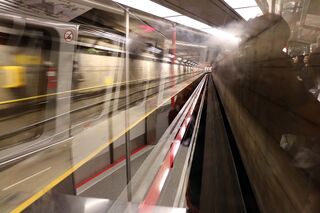Coronavirus Disease 2019
How Seattle Withstood a 6.8 Earthquake Without Disaster
Tackling seismic risk meant that the 2001 shaking avoided a catastrophe.
Posted May 21, 2021 Reviewed by Ekua Hagan
Key points
- Major earthquakes do not need to become disasters, as shown by Seattle's preparedness for their 6.8 quake in 2001.
- Since 1971 the Seattle region had fostered an "earthquake readiness culture" by upgrading building structures and giving emergency training.
- An earthquake 100 times stronger than a 6.8 is expected in the Seattle area at some point, making long-term planning still crucial.
At 10:54 am on February 28, 2001, Seattle and the surrounding area shook in the Nisqually earthquake. Centered about 60 kilometers southwest of the city at a depth of 52 kilometers, the tremor clocked in at a moment magnitude 6.8 — not one which could be ignored.

Yet no widespread catastrophe emerged! One immediate death occurred from cardiac arrest, along with several other heart attacks in the following days. Hundreds were injured.
The payoff of long-term planning and luck
How could a major earthquake not lead to a major earthquake disaster? The answer is straightforward: long-term risk reduction through preparation, planning, and damage mitigation.
Earthquakes similar to 2001 rattled the area on April 13, 1949, and April 29, 1965. From those experiences, the region had improved the seismic safety of planning and construction. The consequences of 2001 displayed the successes.
Bridges retrofitted and upgraded over previous years fared well. Many slated for future improvement suffered damage and closure. Several large buildings sported earthquake scars but did not collapse or kill anyone.
The good news covered more than infrastructure. Since 1971, Seattle and the area around it had focused on a readiness culture, training residents for emergencies. Free CPR training alongside public defibrillators continually saved lives.
More to the point was instilling principles of first aid: First, prevent. Second, think and prepare before a crisis. Third, intervene only if safe to do so.
Can basic emergency training cause wider outcomes of community spirit and long-term prevention? Scattered anecdotes support this link, but proving definitive connections is not easy.
A tangible initiative with clear results in 2001 was Seattle embracing the US government's Project Impact to bring together residents and businesses for hazard preparedness. Project work around Seattle highlighted local action for dealing with earthquakes.
This meant raising awareness, disseminating information, and upgrading building structures. Many earthquake-affected people related stories of how Project Impact had saved their lives or reduced their property damage in 2001.
Yet on the day of the earthquake, President George W. Bush's first budget proposed that Project Impact be canceled. Despite those affected by the earthquake evidencing the calculable savings in lives and money due to just a few years' work, Bush's proposal was upheld and Project Impact was eliminated. The previous US administration's foresight to invest small amounts of money for a huge positive payback had been abandoned.
Nevertheless, not all of 2001's success was strategically planned. On the evening before the earthquake, riots had convulsed an older part of Seattle, so the next day dawned with these parts sealed off to the public.
As the earth moved, bricks rained down on the empty streets, damaging vehicles and demonstrating that many people could have died. Ten years later in Christchurch, New Zealand, several people were fatally buried during a tremor as brick façades collapsed onto them.
Future earthquake preparedness in the Seattle area
The 1949, 1965, and 2001 earthquakes were tame compared to what Seattle's region could experience. Shaking one hundred times stronger than each of those is expected at some point. Making it through one 6.8 comparatively unscathed does not necessarily mean that 9.1 — or even the next 6.8 — will be fine.
Then, the possibility for post-earthquake flooding manifests. Tsunamis are major concerns. Seiching could also happen, in which a body of water sloshes back and forth due to the shaking, deluging the shoreline.
All this is known and can be prepared for with advance thinking and long-term action. Supporting Project Impact was a clear choice to help avoid disasters in contrast to stopping it as a clear choice to accept disasters. We have choices to ensure that an earthquake does not become an earthquake disaster.
Additionally, we must think and act beyond earthquakes. Seattle sits within striking range of active volcanoes. Landslides, floods, storms, heat, cold, wildfires, and more affect those in the area. How well prepared are the residents for a meteorite strike, solar storm, or pandemic — COVID-19 or otherwise? What other potential perils ought to be considered?
Thinking and acting ahead of one possible difficulty, such as an earthquake, helps in thinking and acting ahead of all the others. The parallels are not always exact, yet focusing on people being ready to help themselves and each other along with robust infrastructure goes a long way toward countering a diversity of problems.
The 2001 Nisqually earthquake shows how much can be achieved — and how much yet remains to be done.
References
Culley, L.L., T.D. Rea, J.A. Murray, B. Welles, C.E. Fahrenbruch, M. Olsufka, M.S. Eisenberg, and M.K. Copass. 2004. Public Access Defibrillation in Out-of-Hospital Cardiac Arrest: A Community-Based Study. Circulation, vol. 109, no. 15, pp. 1859-1863.
Filiatrault, A., C.-M. Uang, B. Folz, C. Chrstopoulos, and K. Gatto. 2001. Reconnaissance report of the February 28, 2001 Nisqually (Seattle-Olympia) earthquake. Report no. SSRP–2001/02. San Diego: Department of Structural Engineering, University of California.
Hess, J.R. 2018. Cascadia Rising: thoughts on a Seattle earthquake disaster exercise. Transfusion, vol. 58, no. 11, pp. 2736-2740.
Perez-Fuentes, G., C. Molina Hutt, T. Rossetto, and H. Joffe. 2017. Are residents of Seattle ready for ‘the Big One? An intervention study to change earthquake preparedness. In the Proceedings of the 16th World Conference on Earthquake Engineering from the National Information Centre of Earthquake Engineering, Santiago, Chile.




